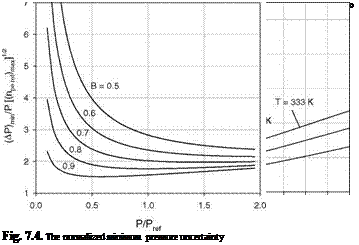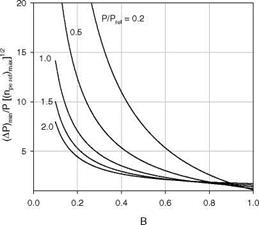Photodetector Noise and Limiting Pressure Resolution
The uncertainties in the outputs V and Vref from a photodetector (e. g. camera)
are contributed from a number of noise sources in the detector such as the photon shot noise, dark current shot noise, amplifier noise, quantization noise, and pattern
noise. When the dark current and pattern noise are subtracted and the noise floor is negligible, the detector is photon-shot-noise-limited. In this case, the signal-to – noise ratio (SNR) of the detector is SNR = (V/GhvBd )12, where h is the
Planck’s constant, v is the frequency, Bd is the electrical bandwidth of the detection electronics, G is the system’s gain, and V is the detector output. The uncertainties in the outputs are expressed by the variances var(V) = VGhv Bd and var(Vref ) = Vref GhvBd. In the photon-shot-noise-limited case in which the error
 |
||
propagation equation contains only two terms related to V and Vref, the pressure
which holds for both CCD cameras and non-imaging detectors.
 |
For a CCD camera, the first factor in the right-hand side of Eq. (7.4) can be simply expressed by the total number of photoelectrons collected over the integration time (^ 1/ Bd ), npe = V /(G h vBd ). When the full-well capacity of
where (nperef )max is the full-well capacity of the camera in reference conditions.
When N images are averaged, the limiting pressure difference (7.5) is further reduced by a factor N1/2. Eq. (7.5) provides an estimate for the noise-equivalent pressure resolution for a CCD camera. When (nperef )max is 500,000 electrons for a CCD camera and Bath Ruth + silica-gel in GE RTV 118 is used, the minimum pressure uncertainty (Ap)min / p is shown in Fig. 7.3 as a function of p/pref for different temperatures, indicating that an increased temperature degrades the limiting pressure resolution. Figure 7.4 shows ^(nperef )max (Ap)min / p as a function of p/pref for different values of the Stern-Volmer coefficient B(T). Clearly, a larger B(T) leads to a smaller limiting pressure uncertainty (Ap)min / p. Figure 7.5 shows <J(nperef )max( Ap)min / p as a function of the Stern-Volmer
coefficient B(T) for different values of p/pref. There is no optimal value of B in this case.
 |
Fig. 7.3. The minimum pressure uncertainty (Ap)minf p as a function of p/pref at different temperatures for Bath Ruth + silica-gel in GE RTV 118. From Liu et al. (2001a)
function of p/pref for different values of the Stern-Volmer coefficient B(T) . From Liu et al. (2001a)
|
Fig. 7.5. The normalized minimum pressure uncertainty (nperef )max( dp)mn / p as a function of the Stern-Volmer coefficient B for different values of p/pref. From Liu et al. (2001a) |














